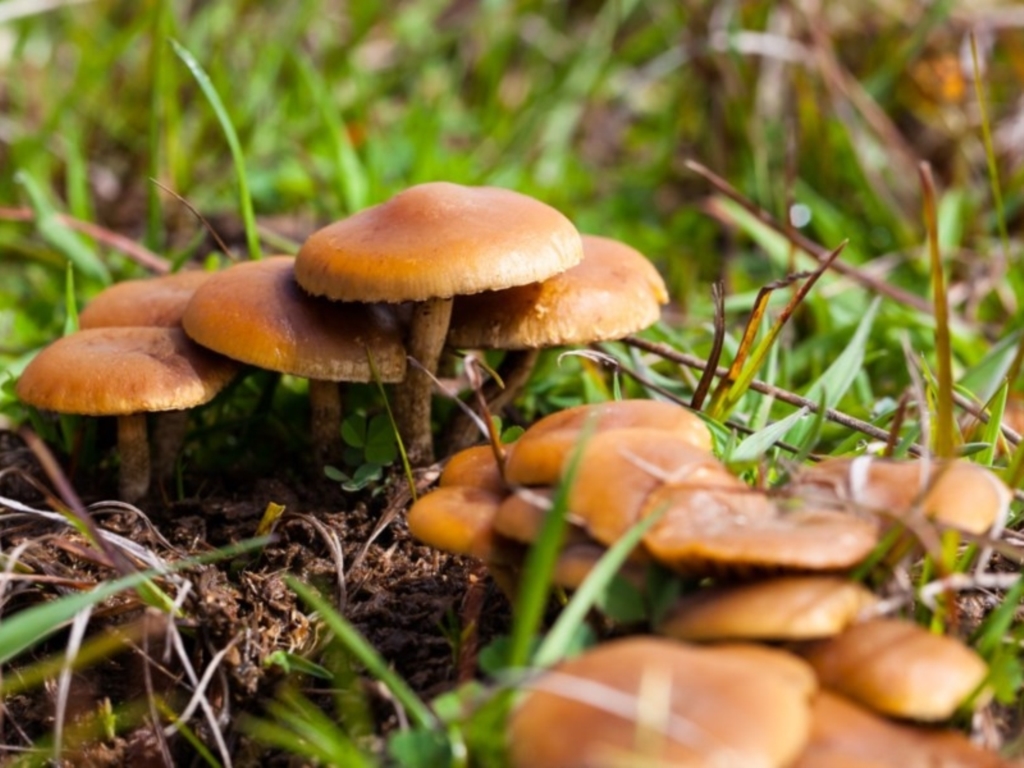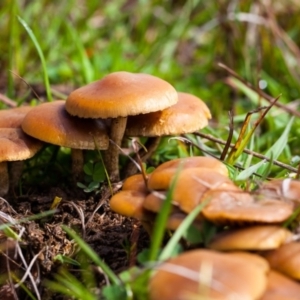Murrumbateman, NSW
Identification history
| zz agaric (stem; gills white/cream) | 8 Sep 2016 | Heino | ||
| Unidentified | 6 Sep 2016 | SallyandPeter |
Identify this sighting
Please Login or Register to identify this sighting.
4 comments
Heino
wrote:
8 Sep 2016
There's a chance that this is a species of Pholiota. In many Pholiota species the caps are some shade of brown and often the stems are scaly, except in the uppermost quarter or so. In many species the caps are a few centimetres in diameter, though they may be much larger in some species. The stems in this photo could be scaly and the overall look is one that would make me think Pholiota if I saw this cluster while walking along. However, all the evidence in the photo is still fairly weak and I know that out in the field I'd need to get down and have a good look at these mushrooms from various angles and, while my confidence in Pholiota might grow, I know that there is still a possibility that my field identification might change on closer study. It is a very nice photo but I won't put a genus on this and only go as far as saying Agaricales.
SallyandPeter
wrote:
9 Sep 2016
Thanks for such a detailed reply. There are so many fungi and I no nothing about them. CNM is such a great local resource, thanks for you time. All the best, Peter
Heino
wrote:
9 Sep 2016
Peter, I'll make a few comments that may be of some use when looking at fungi. However, first a warning. Some fungi are easy to identify, even from poor photos, but some, no matter how good the photos, can never be identified from photos alone. You can increase your chances of an identification by looking from different angles. Where you have a stem and cap, there may be useful identification features on the upper side of the cap, on the lower side of the cap and on the stem. If you can, photograph what you see.
Knowing the spore colour can be very useful at times and sometimes you can see this in the field. In this photo (http://www.cpbr.gov.au/fungi/images-captions/entoloma-sp-0248.html) you see the cap of one mushroom overlapping the cap of another. The right half of the one cap is a flesh-pink. Entoloma spores are pinkish and what you see on that cap is a mass of spores that have fallen from the gills of the upper cap. In this case the spore deposit carries a lot of information, since there are very few genera with a pinkish deposit. Where you get overlapping caps, it pays to check for a spore deposit, but note that you won't always see one easily. If you're not familiar with spore prints, you can check out this page (http://www.cpbr.gov.au/fungi/spore-prints.html) and have a go.
There can be changes with time, so photographing both immature and mature specimens can help, since some features are much easier to see in a young specimen. Where you get a group you will often (but by no means always) see specimens at different stages of development. As an example of what can happen. The shaggy coating on the young caps of this species (http://www.cpbr.gov.au/fungi/images-captions/coprinus-sp-0249.html) disappear, either mostly or totally, with age. Here (http://www.cpbr.gov.au/fungi/images-captions/coprinus-sp-0250.html) you see caps in various stages of shedding.
Knowing the spore colour can be very useful at times and sometimes you can see this in the field. In this photo (http://www.cpbr.gov.au/fungi/images-captions/entoloma-sp-0248.html) you see the cap of one mushroom overlapping the cap of another. The right half of the one cap is a flesh-pink. Entoloma spores are pinkish and what you see on that cap is a mass of spores that have fallen from the gills of the upper cap. In this case the spore deposit carries a lot of information, since there are very few genera with a pinkish deposit. Where you get overlapping caps, it pays to check for a spore deposit, but note that you won't always see one easily. If you're not familiar with spore prints, you can check out this page (http://www.cpbr.gov.au/fungi/spore-prints.html) and have a go.
There can be changes with time, so photographing both immature and mature specimens can help, since some features are much easier to see in a young specimen. Where you get a group you will often (but by no means always) see specimens at different stages of development. As an example of what can happen. The shaggy coating on the young caps of this species (http://www.cpbr.gov.au/fungi/images-captions/coprinus-sp-0249.html) disappear, either mostly or totally, with age. Here (http://www.cpbr.gov.au/fungi/images-captions/coprinus-sp-0250.html) you see caps in various stages of shedding.
SallyandPeter
wrote:
10 Sep 2016
Thanks Heino for this info. I will digest all this and get out in paddock and have a look and see what photos I can get. Thanks again Peter
Please Login or Register to comment.
Nearby sightings
Location information
- Coordinates 149.066899-34.975193
- Places Murrumbateman, NSW
Sighting information
- 16 - 100 Abundance
- 5 Sep 2016 12:00 AM Recorded on
- SallyandPeter Recorded by
Species information
- zz agaric (stem; gills white/cream) Scientific name
- Common name
- Not Sensitive
- Local native
- Non-Invasive
- Up to 1407.5m Recorded at altitude
- Machine learning





























